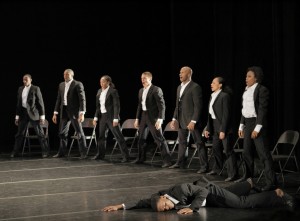Southern California is old, good friends with the Alvin Ailey American Dance Theater, with a rightful claim to a crucial piece of Ailey choreographic history (the Lester Horton connection was forged here) and a revered longtime company member (Matthew Rushing). Ailey concerts have a party atmosphere at the Dorothy Chandler Pavilion — the houses are full of high-spirited, dramatic revelers. Based on the number of giddy, lurching people who came through my row each night, a certain portion of the house was totally pissed during the Ailey run last month.
For better and for worse, the codified audience clapping during the final segment in “Revelations” has set the expectation that ticket holders will share a collaborative moment with the company by the final bell of the evening. On this tour, the communion began sooner, with the Ailey company’s Los Angeles debut of Ohad Naharin’s “Minus 16” (which I reviewed in full for the Los Angeles Times). The spiritual fervor one associates with the company, often dished in syrupy forms, found restoration in Naharin’s grungy and impassioned shakedown. And in the latter half of the piece, when a handful of audience members were invited onstage with the dancers, the work’s smart theatrical beauty carried the whole auditorium to a new level of intimacy with the troupe.
Ailey’s Los Angeles debut of Jiří Kylián’s “Petit Mort” was also cheered, but in a way that bugged me. Why don’t I trust that the crowd appreciated the piece for its aesthetic gifts? Perhaps because the dance audiences at the Music Center seem to go wild with relief for any eroticism onstage, as if watching anything besides silky slithering at a dance concert is some painful, dutiful act. (On the Joffrey’s program in February, which presented the 100the anniversary of “Rite of Spring” to average applause, the whoops and hollers for Christopher Wheeldon’s tangled duet in “After the Rain” were over the top, with patrons leaping to their feet to cheer.)
Clearly, artistic director Robert Battle has Ailey devotees forefront in his mind. Ever since the 50th anniversary of “Revelations” in 2010, there’s been no bill that’s required audiences to forge an evening without that extraordinary, lasting work. It’s working great for ticket sales as well as showing up Ailey’s consummate choreographic strength. For it seems that no matter what choreographic detail shines in the nourishing repertory Battle brings in (from new work by Kyle Abraham or company firsts tackling Paul Taylor and Ohad Naharin) you can find that same special structure visible, as well, somewhere inside “Revelations.” Yet that echo, in turn, refers one back to the new repertory’s beauty one more time. Thus what seems like a resignation from Battle (that there can be no program without “Revelations”) actually feels like the reverse. By having us look at Naharin and others alongside Ailey, he’s showing a little bit of everyone inside of Ailey and a little bit of Ailey inside of everyone else.

I have mixed feelings about this programming strategy:
“Thus what seems like a resignation from Battle (that there can be no program without “Revelations”) actually feels like the reverse.”
It reminds me of the parental ploy “eat all your vegetables and you can have some dessert,” making spinach into a chore, and Revelations into a bowl of ice cream.